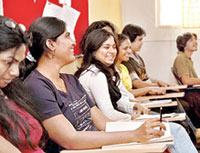Mechanics of Group Discussion
Sakshi Education

In a Group Discussion a limited number of persons discuss a problem or a proposal threadbare and arrive at a consensus. This type of Group Dis-cussion may help solve an organi-zation's problem and facilitate its growth. Nowadays along with inter-views, Group Discussions are being conducted to evaluate the abilities and accomplishments of applicants for employment.
Usually about ten candidates are made to sit in a circle to discuss an issue thoroughly and arrive at a broad consensus. The candidates are visible to one another. The topic would be announced a little before the discussion for preparation. As a rule nobody conducts the discussion. The candidates themselves have to organize it. Anyone of them may assume leadership and start the discussion. The participants put their heads together and try to generate more light than heat. In fact, the entire exercise that may last twenty minutes or more, is a disciplined display of equable behaviour and cogent logic. The candidates are observed and their performance is evaluated by monitors.
Aknowledge of the following prerequisites may be useful in creating a positive impression to the monitors of the Group Discussion:
Leadership qualities as evidenced by
Do's for the participants
Usually about ten candidates are made to sit in a circle to discuss an issue thoroughly and arrive at a broad consensus. The candidates are visible to one another. The topic would be announced a little before the discussion for preparation. As a rule nobody conducts the discussion. The candidates themselves have to organize it. Anyone of them may assume leadership and start the discussion. The participants put their heads together and try to generate more light than heat. In fact, the entire exercise that may last twenty minutes or more, is a disciplined display of equable behaviour and cogent logic. The candidates are observed and their performance is evaluated by monitors.
Aknowledge of the following prerequisites may be useful in creating a positive impression to the monitors of the Group Discussion:
- Immaculate dress consisting of a dark coloured shirt and a light coloured trousers or vice versa, a suitable tie and polished shoe are ideal, for men candidates. For women candidates, saree and blouse or decent salwar and kammej or formal suit (women) and sandals are good enough. Gaudy clothing and heavy ornaments look garish.
- The candidates must carry with them relevant accessories that could throw light on the issue under discussion and strengthen their viewpoints.
Leadership qualities as evidenced by
- Taking initiative and starting the discussion.
- The ability to give a direction to the discussion
- Taking the rest of the group along.
- Listening well and summing up the discussion at different stages and facilitating further discu-ssion for more light.
- Highlighting the main points presented by different parti-cipants and summing up to give a cohesive look to the group so that all stand on one platform.
- Presentation of details in support of main points.
- Error-free presentation of basic facts, avoiding doubtful quant-itative figures and numbers.
- The use of arguments relevant to the topic
- Examples and illustrations offered
- Logical and effective prese-ntation
- Identification of main points
- Abandonment of inessential minor points
- The strong stand taken by the candidates.
- The flexibility in the approach which helps the participant change or revise his ideas, if necessary.
Do's for the participants
- Keep each span of argument short but relevant and interesting.
- Speak in such a way that your arguments are intelligible to the other members of the group. Pronounce words correctly. Use simple and straight forward words. Avoid repetitions. Avoid lengthy sentences. Take minimum time to put forth your arguments.
- Give time for others to make their own contributions.
- Sum up the arguments at regular intervals, so that, further contri-bution may be made.
- Express your views rather slowly but firmly so that others can follow your line of argument.
- Be polite, friendly and acceptable to the other members of the group.
- Substantiate your views with suitable examples.
- Show confidence in your abilities.
- Don't speak loudly.
- Don't adopt a negative attitude resulting in counter arguments with no positive contribution to the group discussion.
- Don't look at the other members of the group rather casually and carelessly. In the Group Discu-ssion no member is supposed to be superior to another.
- Don't wave your hands in emo-tional gestures or in desperation or in anger.
- Don't talk too fast, otherwise, the other members will not be in a position to follow you or under-stand your arguments.
- Don't be magnanimous and provide opportunities for others to speak. Don't try to transfer your chances to others.
- Don't be emotional and shout or thump on the table. Emotional outbursts destroy your equable temper and affect your coherence of thinking and expression.
- At the end, the leader must summarize and present his/her team's recommendations.
Theparticipants must augment their discussion with a little body sport. They must firmly seat in their chairs exuding confidence in them-selves. They must also place their hands in the lap with right hand atop the left.
All said and done, every parti-cipant is a distinct individual and therefore he must project his own distinct personality with leader-ship qualities. However, he must respect the personality and views of other participants as well.
Dr. P. Eliah
English Professor & Academic advisor, JNTU, Hyderabad
All said and done, every parti-cipant is a distinct individual and therefore he must project his own distinct personality with leader-ship qualities. However, he must respect the personality and views of other participants as well.
Dr. P. Eliah
English Professor & Academic advisor, JNTU, Hyderabad
Published date : 11 Mar 2014 04:31PM



















